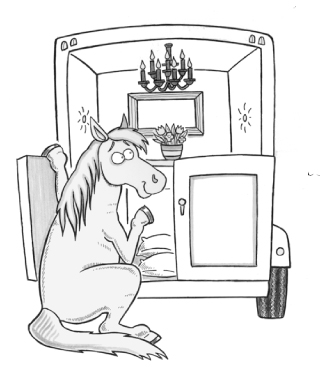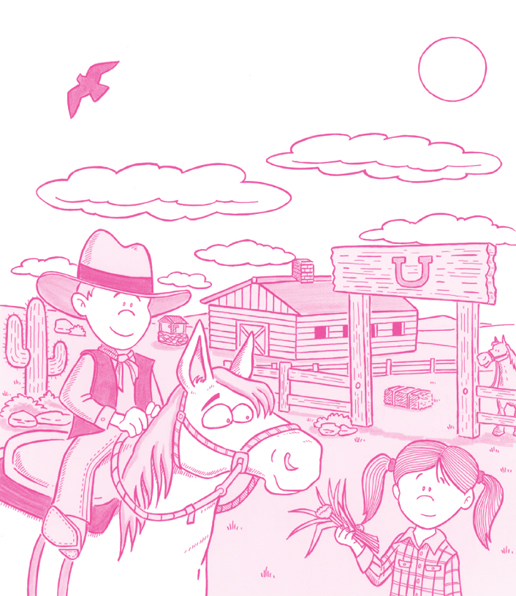
Chapter 26
Just Horsing Around

What am I?
The state my name comes from is famous for songs about horses. My name also implies that I may not like to run. What am I?
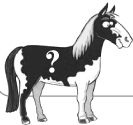 Tennessee Walking Horse
Tennessee Walking Horse
Weird Facts
Has one of your grandparents ever said “Ah, horsefeathers,” when they thought you were fibbing to them? Did you know some horses have feathers? They're those big tufts of hair that are on the back of the legs of a Clydesdale (and a few other types of horses).
Do you think horses still have toes? You probably know that each hoof is like one great big toe, but does a horse have any more toes than this one? If you have an adult who is able to help you, feel the bump on the back of the horse's front leg where your elbow would be. Then check the bump under the feathers on the backside of the hoof. These bumps are called chestnuts and ergots. Don't they feel like toes? At one time, millions of years ago, they were!
Giddy Up
Danger in the Dark
Riding at night is not recommended for you or your horse. Even though horses can see very well at night, no one can guess what dangers might be missed in the dark. If you ever do have to go out in the dark, be sure to wear reflective clothing and use lights that you can mount on your stirrups.
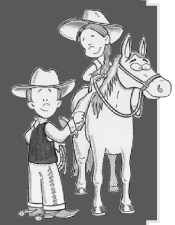
Going to the Dentist
Have you ever wondered if horses have teeth like ours that need to be cleaned by a dentist or brushed twice a day? As you found out earlier, people can tell a horse's age by his teeth and they can also tell your age by looking at your teeth. Unlike human teeth, horses' teeth develop sharp edges and so they need to be smoothed twice a year by a veterinarian, who is also their dentist. A horse's teeth continue to grow throughout the horse's life, so they should never develop cavities or need false teeth like people might need when they get older.
When you go to the dentist, how would you feel if he said “Open wide,” and then reached for an enormous file like the one used on a horse? Then you might wonder how big the horse's chair would have to be, and if the vet could ever get the horse to lay down for any amount of time at all. Most wild animals need to have a shot to calm them down so they can be moved from place to place because they get scared and nervous when they have to leave their home. If a horse is tame or trained, it is much easier to get it to do what you want and to give it the care it needs—hopefully without a shot!
Invisible Horses
Circle the horse word hidden in each of these sentences. Look for words from the list, but be careful! There are extra words in the list that aren't used.
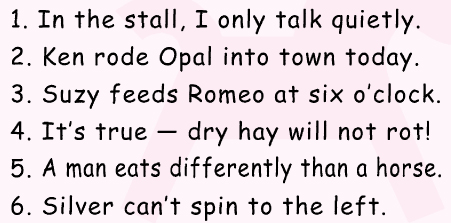
hoof
mane
oats
colt
pinto
rodeo
canter
trot
stallion
Do Horses Have Tusks?
Most horses do have tusks! Some horses' tusks just don't come through their gums. Horses' gums are never completely filled with teeth. They have empty spots between their front and back teeth that are called bars. You can reach through these openings to rub their tongues or you can place the bit of their bridle in this space.
Some horses also have teeth called wolf teeth, but they don't usually get to keep them. The veterinarian usually takes out the horse's wolf teeth because they get in the way! When you try to put the bit into the horse's mouth, the wolf teeth are right in front of the first molars in the horse's jaw.
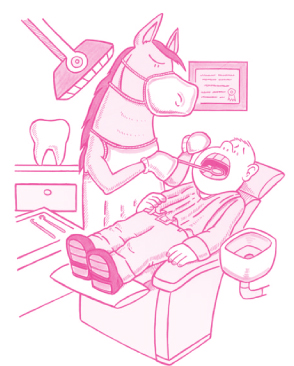
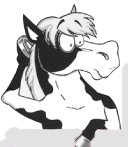 Fun Fact
Fun Fact
Shake, Rattle, and Roll
Like dogs, horses like to roll in the grass and run around in circles. Because horses do enjoy rolling around as soon as they are turned loose, it is always best to remove their saddles as soon as you are finished riding.
Do Not Touch
How will your horse know that you really like him if you don't pet him like you would any other pet? Your trainer will tell you that the more you stroke your horse while you are grooming or training him, the better your relationship will be:
1. Horses just don't like to be lightly touched! Pet your horse with a firm touch so they don't think that you are one of those pesky flies and react by trying to kick you!
2. Some people say horses don't like to have their nose petted, but that they would rather have you pet them between their eyes.
3. Don't force a horse to accept you touching either its nose or between its eyes; it might make the horse jump or spook whenever you reach for its head.
4. It is also important to teach your horse to respect your space and never crowd you when you are grooming him.
5. It's a good idea to tie a horse up (at its chest level) before you start grooming it, so that you don't get hurt by the horse moving around, and so that your horse doesn't get injured if it gets startled while being groomed.
What am I?
By my name you might think that I am a very cold horse, but actually I am just known for the cold place that I come from.What am I?
 lcelandic Pony
lcelandic Pony
Pay close attention to how your horse reacts to the way you take care of it. You should be able to tell what makes your horse happy or what it doesn't like. Sometimes keeping a horse happy simply involves getting rid of a few flies. In some stables you may see sticky tape used to keep the flies away from the horses. For fun, how about wrapping a large box with double stick tape, making a target on it, and then throwing cotton balls at it to see who can get the most balls to stick?
Let's Go to the Rodeo
Most rodeo horses today are specialists and only compete in certain events, unlike the cowboy's working horses of the old West that had to be able to do everything connected with working with cattle.
Horses are a large part of the rodeo. They have many different jobs that range from helping to lasso a calf to performing show tricks. You can have your own rodeo by steering your bike around obstacles like cardboard boxes, throwing a ball through hoops, riding between tires, and picking fags off of trees.
Bucking Broncos
In the old West, cowboys usually wanted to celebrate and compete with each other after they finished herding the cattle to market. Have you ever been to a rodeo? Some cowboys decide they want to travel all over the country and demonstrate how well they ride cattle and untamed horses called broncos.
When a cowboy tries to ride a bronco for the first time, the horse will buck and jump straight up into the air. The horse isn't sure what is on its back and, like its ancestors, it wants to remove whatever it is. A bronco will also try to scrape off whatever is clinging to its back by rubbing against the fence.
Words to Know
Bronco
A bronco, or bronc, is an undomesticated or wild horse. Bucking broncos can be seen at most rodeos, waiting for a cowboy who is brave enough to try to “bust” or them.
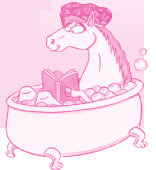
 Fun Fact
Fun Fact
Can You Believe It?
For many years, people have known that when you combine a horse with a donkey, you get a mule. But what happens when you combine a zebra with a donkey or a zebra and a horse? You get a zonkey and a zorse.
Ouch!
What did the rodeo rider say when he got bucked off his horse?
Write the answer to each question on the dotted lines. Then put the numbered letters into the grid to find out
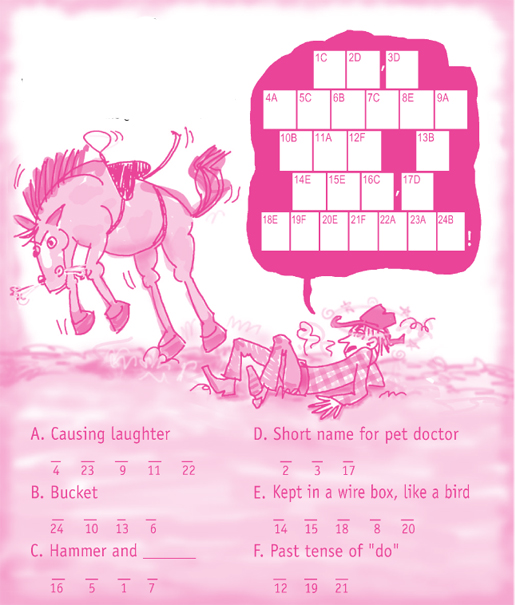
Even though the same broncos may be used in a few rodeos, most of them remain untamed. In fact, the more the broncos buck, the better the cowboys and the rodeo crowd like it. Sometimes they try to rear up and stand on their back legs. Cowboys never pull back on the reins when the horse does this; it could make the horse fall over backward and injure its rider.
 Fun Fact
Fun Fact
Cowboy Slang
When a horse bucks, some cowboys say it is “sunfishing.” Some other cowboy words for riding their horses are ambling, loping, and jogging.
All Tied Up
Cowboys have to learn how to do many jobs so that they can catch and herd cattle; they use most of this knowledge when they compete at their rodeos. The cowboy's horse is his most important tool. When you go to the rodeo, notice that the horse seems to do many jobs without any instruction from the rider—this is because the horse is so well trained! A good cutting horse can separate a calf from the rest of the herd as soon as it is shown which calf the cowboy wants.
Sometimes, horses are too smart—they can learn how to untie their ropes from their tie-down using their teeth! Have you ever seen a cowboy lasso a calf? After the rope is around the calf's neck, the horse will stop and slowly back away, while the rider jumps down and ties the calf's feet together. A cowboy doesn't always use the same knot for every task. Would you like to learn to tie some knots? You can look up knot tying in encyclopedias, books, or on the Internet.
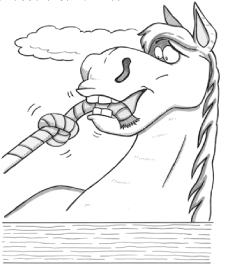
Words to Know
Lasso
A lasso is a rope formed into a circle by tying a special knot in it. Cowboys use these lassos to catch both horses and cows. Another name for a lasso is a lariat.

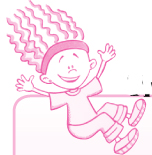 Try This
Try This
Lasso knots
To make a lasso type of knot: Take a piece of yarn and on one end make a circle, then pull the same end partway through the circle. Before you pull it tight, feed the other end of the yarn through the circle, leaving a big loop that you put your finger in. Now pull the first end tight.
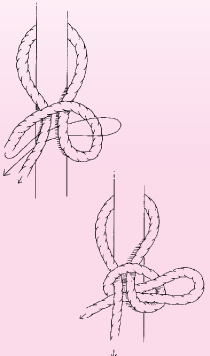
One knot you should learn how to tie well is a “quick release knot.” This knot is safe for when you are grooming your horse, because if something happens to scare your horse, you can untie the knot just by tugging on one end of the rope. This way, your horse won't hurt his back or neck by moving suddenly while tied to a post.
Learning a New Trick
Do you think that there are many people who wish that they had grown up to be cowboys and cowgirls? Lots of people attend barbecues, go line dancing, dress up for square dances, go on hay rides, and tour ranches and horse farms—all of these are activities cowboys and cowgirls would like too! Have you ever gone on any trip like this?
Eventually many of the people who want to be cowboys and cowgirls buy horses because they enjoy the life that goes with ownership of a horse. You should try some of these activities and see if you would enjoy this life too! Ask an adult to help you find square dancing lessons in your area, or to take you on a hay ride in the fall!
Horses on the Move
Have you ever moved? Most people move several times in their lives. Like people, horses don't always stay where they were born. Some horses are sold and travel only a few miles away while others go from one country to another. Horses also move from place to place to race, compete in events, and travel in shows. Some horses even get to go on vacation with their owner's family! Some national, state, and county parks and many privately run campsites offer places to tie up your horse. Some even come equipped with stalls for you to keep your horse in while you are there.
One of the most popular ways for a horse to travel is in a special horse trailer. Maybe you have seen one of these trailers while you were on vacation or just traveling to another place. For fun, try counting all the trailers or horses you see on your next trip; you might be surprised to learn how many horses are on the road!
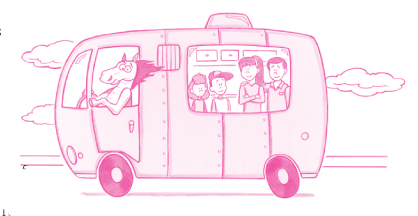
Some riders like to hobble their horses as well as tie them up. Hobbles are loose ropes that are tied around two of the horses' feet so that the horse can't move around so much and so that the horse learns to stand still when told. Would you and some of your friends like to see how fast you could go if you were hobbled? You can get the same effect by having a sack race or holding one of your friends up by their legs while they race on their hands.
Horses with Passports
Have you ever traveled to another country? Most of the time you need a passport to leave the country and also to re-enter it. Horses that travel from country to country need passports for the same reasons people do. It tells what the horse's name is, who its parents are, some of its grandparents' names, when and where the horse was born, and its registry in the studbook.
 Fun Fact
Fun Fact
No Bones about It
Although there are horses in Australia now, this wasn't always the case. Australia is the only continent on the planet where no horse fossils have ever been found!
You may know someone who has a tattoo. But did you know that horses also wear them, to help their owners prove the horses are who the owners say they are. You probably have heard of housesitters and babysitters. Sometimes horses need someone to look out for them, just like you. When people travel with these valuable animals, someone has to stay with them all the time—so you could say they have horsesitters!
Words to Know
Passport
When you travel from your home country to another country, most places require you to bring a special identification card with your picture on it, called a passport. When horses travel their owners have to show passports for the horses as well.

Shipping Horses
Did you know that you can enter your horse in events located all around the world? Transporting horses for long distances by trailers, boats, or planes can be difficult, expensive, and involves a great deal of paperwork to make sure your horse is allowed to run after it gets there.
If you ship your horse by boat, you are part of a long tradition going back to the ponies that were brought to Iceland by Vikings. After the time of the Vikings, Spanish horses were transported in boats so that their riders could fight against English soldiers. Many of the Spanish horses had to swim to shore when the battle was lost and the Spanish ships started to sink.
Giddy Up
Kicking Up Your Heels
For a horse, kicking is more of a reflex than a choice. Like any other large animal, it is always best to stay off to the horse's side. Never stand behind him or bend over and go under the horse's neck where he can't see you; it's much safer to walk around in front of him.

Have you ever ridden in a sailboat? If the winds don't blow, you have to wait until they do before you can move. Many horses died aboard ships that were bound for the New World because the ships had to wait for a breeze to reach an area of the ocean east of Mexico and the horses couldn't survive on the boat that long. Because of this, the sailors called this part of the world “the horse latitudes.”
Even when horses travel, they compete with other horses to arrive first to their competitions. Have you ever thought about holding your own horse race at home? All you will need is a chessboard and the chess pieces:
1. Line up your knights, bishops, castles, queens, kings, and pawns on the board. You can use both colors and assign a piece to each player.
2. Roll one die to determine how many spaces the players can move.
3. Keep rolling the die until one player reaches the other side.
What am I?
I have been mountain climbing in Spain for many years and my name sounds like I could have been missing something. What am I?
 Andalusian
Andalusian
Where In The World
Figure out the six rebus puzzles to see where your horse could travel.
HINT: The answers will sound correct, but may not be spelled correctly!
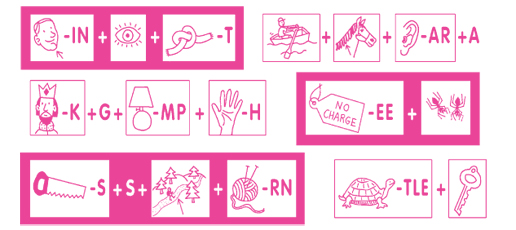
 Try This
Try This
Happy Trails
See if your family can take a day sometime to take you somewhere where they offer trail rides or a pony ride. If you don't have any horses nearby, how about going for a day on a walking or biking trail? If you have time, you can have a picnic along the way.
Trailing Along
Whenever you move your horse, be sure to put its shipping boots on it, so it won't be injured and be sure to have a first-aid kit for you and your horse whenever you travel. Shipping boots are padded boots that wrap around your horse's lower legs and protect them while your horse is being moved in a trailer.
Many horses do not like to cross bridges or enter a dark barn or trailer. Maybe they think that they are going to be trapped and unable to use their best defense, which is running away. Horses will fight, if they can't avoid it, by using their hooves and teeth as weapons.
If you are thinking about buying a horse, ask to see a demonstration of how willing he is to enter a trailer. The best way to avoid a traveling problem is to take a foal, preferably with his mother, on frequent trips as he growing up. If this is not possible, try to load him with another horse for a few trips. Always have an assistant and lots of time when you are teaching a horse this new trick. It helps if the trailer is well lit, especially so the horse can see out the other end. You also need to be able to close this opening after the horse is loaded, so a cold wind doesn't blow in and make your horse chilly!
Have you ever tried to ride in something while you are standing up? You might slide or even fall. A horse in a trailer has nothing to hold on to, so it is best that the driver slows down for turns and curves.
